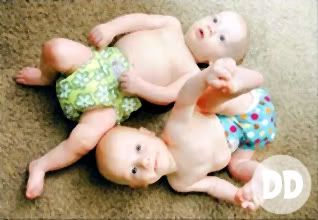Green Parenting - These aren't your mom's cloth diapers
Earth-friendly, cute and absorbent: Parents rave about the new cloth diaper.
BY CHRIS KRIDLER
FLORIDA TODAY 7th May 2007
Diapers may not seem much of a topic for conversation, until you're changing 10 or more a day. Then you start thinking about them. You start thinking about chemicals and landfills and how much money they cost. And then, if you're Julia Clark, you discover a new old solution, in colorful prints, microfiber and Velcro.
These are not your mama's cloth diapers.

"I had never used cloth diapers before, and whenever anybody would mention them, like back when I had my daughter, I imagined them to be like they were back in the '70s," says Clark, 29, who lives in Palm Bay and has 7-month-old twin boys. "I imagined them having to wear little plastic itchy pants overtop."
The old-style diapers were supposed to be rinsed in the toilet and laundered. They sounded like too much trouble.
Then the twins came along, and she and her firefighter husband, Matthew, were given about five months' worth of disposables at the baby shower.
"I told my husband, 'You know, we're getting ready to run out, and we haven't had to spend any money on diapers so far,' " Clark says. "Wonder what it's going to cost to put diapers on twins?"
She came up with a number: about $150 a month. Cloth diapers seemed like a reasonable alternative.
"When I realized how cute they were and comfortable and practical and absorbent, and really not that inconvenient, then I just was like, 'Oh my gosh, I want to open my own business, and we're going to use cloth diapers.' "
Politics of poo
Disposable diapers have been absorbing controversy for a long time, as environmental groups point out their nonrecyclable content and their tendency to accumulate in landfills.
According to the Environmental Protection Agency, there was almost no diaper waste generated in 1960. By 1970, there were 350,000 tons. In 2005, the number had risen to 3.6 million tons annually, with no significant recycling.
While those numbers speak for themselves, a British study suggested all the washing and drying of cloth diapers meant their environmental impact was about equal to that of disposables.
Environmentalists have criticized the study. One green argument is the combination of chemicals in the diapers and their baby waste make for an unhealthy contribution to landfills and potentially ground water. Poo isn't supposed to go into the landfill.
"One thing that I didn't realize is that, if you read the fine print on the disposable packaging, it actually says that you're not supposed to throw away fecal matter, " Clark says, "and nobody knows that."
That's right. Disposable-diaper users are supposed to flush the poo.
Other studies raised more issues. An article in Archives of Disease in Childhood posited that increased warmth from disposable diapers may contribute to male infertility, since "scrotal hypothermia" or cool temperatures are important for reproductive health.
According to the abstract, "This study shows that scrotal temperature, which closely reflects testicular temperature, is increased in boys wearing disposable plastic lined nappies."
Another study, in the Archives of Environmental Health, subjected mice to air blown over three brands of disposable diapers. Their eyes, nose and throats were irritated, and they had decreased airflow, reminiscent of an asthma attack. The disposables, unlike cloth diapers, emitted chemicals "toxic" to the respiratory tract.
Whether these studies can be connected directly to babies' health is unclear, but they make some parents wonder.
Michele Hobbs of Indian Harbour Beach says one reason she uses cloth diapers on her 6-month-old son is for the environment. The other is "the chemicals inside diapers, the gels and the chlorine and all the other nasty chemicals."
Naturally fun
Hobbs likes knowing natural cloth is next to her child's skin. The super-absorbency of some disposable diapers means parents leave them on longer, she says, and she doesn't like the implication for babies.
"They're constantly urinating in the same diaper, so it's like they're wearing a toilet," she says.
Hobbs also subscribes to the idea of "elimination communication" -- if a child sometimes wears no diapers, or cloth diapers that let him feel when he's wet, he learns to let mom know when he has to go. This method has allowed her to get her kids out of diapers sooner, she says.
She argues cloth diapers actually take her less time, because she doesn't have to dash to the store when she's running out.
There are several kinds of cloth diapers available. There are old-fashioned prefolds, basically a square cloth, which require a cover. The nice thing about the soft new covers, for $8 to $20, is that with Velcro, they don't need pins, Clark says.

She likes the lined pocket diapers, which have inserts whose thickness can be customized to boy or girl, overnight or a long car trip. They sell for $12 to $17.
There are all-in-one diapers, too, that go into the wash in one piece.
Clark sells several kinds in her diaper business, online at http://www.earthangelsdiaperco.com.
It's hard to find cloth diapers in stores, she says, but through online vendors, people build their "stash," which they can use for the next little nipper, too.
The basic cloth diapers can save parents money. Or they can go for the luxury models.
"It's kind of becoming more of like a yuppie-type trend," Clark says. "Moms are buying velour, leopard, wool, all kinds of fancy embroidered, custom monograms. You know, I have twins. I can't afford to spend $50 per diaper. But some people are really into it."
















3 comments:
It is so sad all the people that dont understand us: cloth diaper moms... I wish everybody could know how easy it is!!! Seriously!!!
Great article!!
Cloth diapering is so easy. I get comments like oh I cant do that.
I can never clean poo.
Thanks for the informative article!
Post a Comment